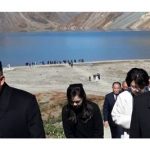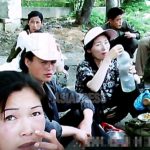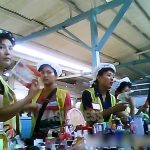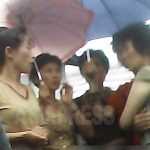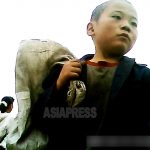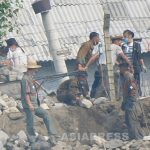2012/May/10
Written by LEE Jin-su
Farming Villages' Crops Taken by the Government
How Farmers' Crops are Taken
There are multiple causes of the current food shortage crisis in North Korea's only breadbasket region. Of particular importance is the crisis in the farming villages. Why are people starving to death in a region of food production? I see the main cause as stemming from the allotment taken by the state. Many famers in Hwanghae are being plunged into a situation they cannot bear anymore.
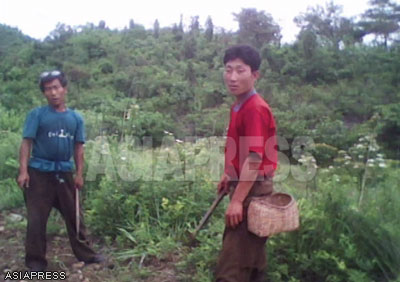
(June, 2010. Photo by Rimjin-gang reporter Kim Dong-cheol) (C) ASIAPRESS
Food Distribution to Priority Recipients Essential
As an advocate of communism, an administrative feature of North Korean is its food rationing system. The government is responsible for guaranteeing access to food, basic everyday items and shelter for everyone. However, the system is in shambles, and since the 1990s, the majority of the people have been removed from of the rationing system. In other words, many more people are living without the "care" of government rations than those living with them.
Currently, the benefits of the food rationing system are limited to only those necessary to maintain North Korea's one party political system. More concretely, benefactors are limited to the Worker's Party and the top brass of the administrative institutions, the Peoples' Liberation Army, the police, the State Security Department, the defense industry, employees and dependants working at the offices of top mines and coal quarries, and the residents of Pyongyang.
In addition to those running the administration, groups responsible for maintaining peace and order required to control the people, workers exporting the mined natural resources that bring in foreign currency, and the city used to showcase the nation's prestige, Pyongyang, are the recipients of a variety of benefits. The majority of these rations are made up of the grains and cereals that are produced by farmers, who make up about 40% of the population . The burden of providing the rations consumed by the army and Pyongyang falls on the major rice producing region of Hwanghae.
The military is estimated to consist of 1.19 million people and the population of Pyongyang is over 2 million people . In addition, as both groups have inadequate means of food production and cannot support themselves, they rely heavily on the region of Hwanghae. In this way, the farmers' production is consumed by city residents and state institutions.
--------------------------------------------------------------------------------------------------------------------------------
(1) According to the South Korean National Statistical Office report "North Korean Statistics (2011)". An exact figure of 36.8% was given in 2008.
(2) According to the South Korean Ministry of National Defense's "South Korean Ministry of Defense White Paper (2010)".
(3) According to a 2008 census done by the North Korean Central Bureau of Statistics, reportedly carried out in accordance with U.N. standards, the population of Pyongyang was 3.25 million. However, it must be said that the credibility of the report is questionable. The entire population of the country was reported at 24.05 million in 1993. Although at least 1 million people starved to death during the Arduous March famine in the latter half of the 1990s, the population was reported to have increased by 2.84 million people. As a result, the population numbers given only for reference sake, and should not be considered exact. In add ition, the area that makes up Pyongyang has been reduced, further decreasing the population of the city.
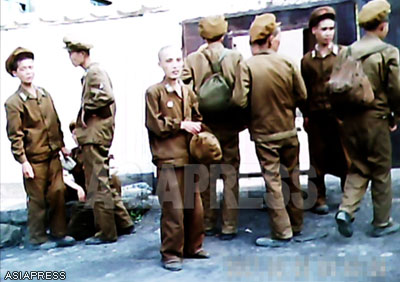
Rations for the Military and Pyongyang Come First
Over the last few years, the lives of the farmers have worsened due to increases in the amount of crops collected by the state. Even in this environment, the collection of food for army rations stands out. Despite the economic bankruptcy of the state, the North Korean administration still attempts to maintain its army, which is about 5% of the total population.
There is a shortage of funds, and it is beyond the state's means to feed such a large non-productive group. As a result, the current condition is that many soldiers in the People's Liberation Army are malnourished and struggling.
Another reason there is not enough food to go around lies in the illegal sales of the rations. While priority is given to the army's collection of food for its rations, some food that was intended to be distributed to peripheral soldiers ends up being sold to markets by top military officials. Ordinary people, who do not receive rations, use money gained from commercial activities to buy food.
Top military officials can gain valuable cash through illegal sales of the rations, without the need for side jobs. The result is that food that was intended for peripheral soldiers ends up being sold illegally in markets. This is widely known by the people of North Korea. However, during the reign of Kim Jong-il and even now, the military first policy continues. The tacit approval of these illegal sales serves to give the top military officials material appeasement, but creates the dilemma of how to deal with the malnourishment of the army. In the end, they are forced to increase the amount of food collected for military rations.
Something notable occurred from the beginning of 2011 until the beginning of spring; food for military rations was collected from people who were not farmers. Although there were variations by region, mandatory collection of a few kilograms of food per person was carried out. In addition, in an unusual turn of events, managers of the markets collected food for military rations from merchants right at the markets, giving the merchants no chance to refuse. This is the first time food for military rations was demanded from groups other than farmers.
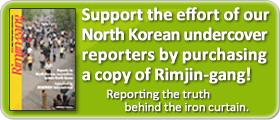
* Editor's notes on North Korean reporters
ALL REPORTS >>>
ARCHIVE(pdf) >>
